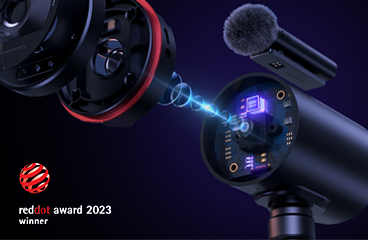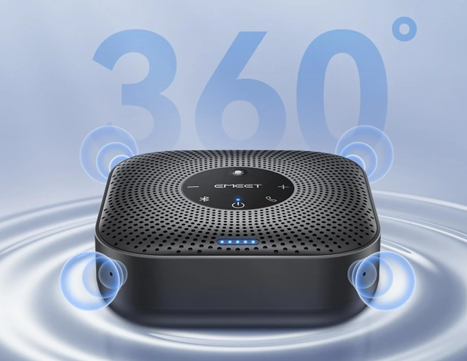What is Suspended Cavity Technology?
The Suspended cavity technology is mainly used in conference products. The technology provides an acoustic shock absorption mechanism for an intelligent voice interaction device. A more straightforward explanation is that the speaker and microphone would not physically contact the box body or any hard body materials. For example, when you have a hammer that has a hard & short handle, and you use it to smash a wall, as soon as the hammer and the wall make contact, it will conduct a significant vibration and defect back to your hand. But then you use a hammer that has a long and flexible handle, the vibration will cancel out, and you will feel less vibration. This is how the suspended cavity technology works.
We would also apply the suspended cavity technology on microphones to eliminate the last little part of the vibration. But, the method is a little different than the speaker; the microphone is actually sealed up and leaves only one spot area for the microphone to pick up audio. Also, the microphone would not be in any way touching the box body.
2 Types of Microphones
Before we start explaining the suspended cavity technology for microphones, we should have a basic understanding of the different types of microphones in the current conference speakerphone market. Two types of microphones are used, which are MEMS & ECM microphones.
1. MEMs Microphone
In MEMs microphones, MEMs (Micro-Electro-Mechanical Systems) components are mounted on a printed circuit board (PCB) and protected from the outside by a mechanical enclosure. The holes in the case are designed to allow sound into the microphone. When the holes are in the top cover, they are designated top-ported holes, while in the PCB, they are designated bottom-ported holes. In MEMs components, a mechanical diaphragm is usually designed on a semiconductor die along with an accompanying mounting structure.

Pros:
- Low power consumes
- Extremely small in size
- Offers improved noise cancellation
Cons:
- Costly micro components
- Due to small size, significant high power transfer is not possible
2. ECM Microphone
ECMs are made up of stationary and moving parts, each of which plays a significant role in the microphone's operation. In simple terms, microphones are transducers that convert acoustic energy into electric energy. This type of driver converts the opposite of loudspeakers, which convert electric energy into acoustic energy. By varying the distance between two capacitor plates, energy can be converted from acoustic to electric in an electret condenser microphone.
Pros:
- Capable for extremely wide frequency response
- Best for voice recording for interviews
Cons:
- Less sturdy
- Low sensitivity compared with MEMs
Microphone shock-absorption design

This is the most detailed image explaining the suspended cavity technology for microphone; as you can see, the microphone is sealed around with specific material and only leaves one open area for the microphone to pick up the audio. The sealing between the sound-receiving hole and a silicone gasket prevents other sounds from diffracting from the structure to the sound-receiving spot.
Sealing the microphone is an additional method to prevent the speaker's audio from interacting with the speaker. Most designers will try to keep the microphone as far away from the speaker, but sealing the microphone would be the most efficient method due to the small area of a conference speaker.

The MEMs microphone uses Poron soft foam materials for sealing, and the foam will comprehensively cover the microphone but only leave one spot for the microphone to pick up audio.

The sealing design of the ECM microphone & MEMs microphone is somewhat similar. Both only leave one open spot that allows the microphone to pick up audio. However, the ECM microphone uses a silicone case for sealing instead of Poron foams.
![]()
Sealing Materials for Microphone
For conference devices, microphones mainly use two types of porous sound- absorbing materials for sealing, which is open cell material and closed cell material.
| Material Category | Image | Features | Applied Product |
| Porous sound-absorbing material |
Open cell material
|
1. Perforated connection surfaces allow sound to penetrate easily 2. Strong resilience 3. Common material:Poron |
EMEET Meeting Capsule EMEET OfficeCore M3 EMEET OfficeCore M2 |
|---|---|---|---|
|
Closed cell material
|
1. The sound is not easy to penetrate the inside of the foam hole 2. Large flow resistance, strong sound absorption 3. High resilience 4. Common material:Silica gel、Foamed silicone |
EMEET OfficeCore M2Max |
Testing Data After Microphone Sealed

Based on the results of the testing, unsealed and sealed microphones have more than a 20dBV difference. This shows the sealed microphone can eliminate a lot of the background noises and the sound from the speaker. This can improve the sound quality of the other party and enable them to hear you more clearly.

Test of audio pickup with a sealed microphone
Another test was conducted, and it showed that the sealed microphone could pick up the audio at a stable rate, but the background noises were not captured. Therefore, the developers need to consider the microphone feedback when designing the conference speakerphones.
Current EMEET Products with Suspended Cavity Technology
Typically, EMEET OfficeCore M2Max & EMEET OfficeCore M3 are the conference speakerphone where the microphone and speaker are placed together. EMEET uses Poron materials to separate the microphone and speaker, so when the speaker produces output, the Poron material will block the audio from transmitting to the microphone and creates feedback.
An example of a device with a separate microphone and speaker would be the EMEET's Meeting Capsule. It separates the microphone and speaker from each other to reduce the chance of them affecting each other. A microphone is located on top of the device, which allows the microphone to pick up audio during the conference meeting and not be affected by the audio from the speaker. The speaker is placed at the lower centre of the device, and the audio is output sideways. Therefore, the Meeting Capsule has created a great distance between the microphone and speaker to provide the best user experience for both parties.


Conclusion
Overall, people have higher expectations of performance on voice interaction devices. Suspended cavity technology can highly improve the microphone quality by eliminating the speaker vibration transmitting to the microphone and causing feedback.





